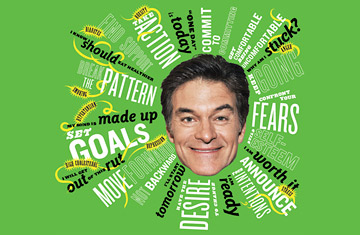
(2 of 5)
Over the years, I have had more conversations like this with patients than I can count, so many that the phrase "I know I should" has become a bright red flag--a sad predictor that I will probably one day crack open those patients' sternums in the operating room, trying to undo the damage that poor choices and unhealthy lifestyles have done to their hearts. Why these people spend their lives moving stubbornly toward major, potentially life-threatening surgery when they could avoid it with just a few wise moves is a riddle that has always dogged me.
But perhaps it shouldn't. Getting people to make meaningful changes in their lives is much more complicated than explaining to them what to eat for dinner, how often to exercise and which kinds of tests they should get from their doctors. The psychology of health is every bit as complex as the biology, and to create seismic shifts in behavior, we have to probe the subconscious.
Psychologists divide behavior into the ego syntonic and the ego dystonic. Ego syntonic is when we embrace a mere fear as absolute truth and the unhealthy behavior that results as justified--as with an anorexic who truly believes she is overweight despite a doctor's scale saying otherwise. Ego dystonic is when, for example, a person with obsessive-compulsive disorder knows that worrying about germs isn't healthy but can't stop anyway. When it comes to behavior, the ego-dystonic sort ought to be easier to fix: you already understand what has to be done. But if that were so, far fewer of my patients would have to make that long trip to the cardiac OR.
There are lots of ways to move the needle on the dystonic problem. A colleague and frequent collaborator of mine, psychologist John Norcross, is one of the authors of a groundbreaking book, Changing for Good, which, as the title suggests, explains not only how to repair what's not working in your life but also how to make those fixes stick. It does this with the help of what's known as the transtheoretical model, which has been around since the late 1970s but is no less powerful now and even has special utility when two-thirds of Americans are overweight or obese and 600,000 of us are killed by cardiovascular disease per year.
The transtheoretical model divides the process of making changes into five key stages: precontemplation, contemplation, preparation, action and maintenance. Precontemplation is in many ways the most dangerous; you have no plans to make any changes and may not even be aware you have a problem. This is often the state of the early-stage alcoholic who clearly has a problem but has not yet lost a job or cracked up a car and can thus pretend everything's fine. It's less common in cases of obesity or smoking. There are too many reminders, from the warnings on cigarette packs to the pains in your chest to the numbers on the scale.
Much trickier are the contemplation stage, in which you begin to recognize the problem and weigh taking action, and the preparation stage, when you intend to act imminently. People who get stuck at "I know I should" generally get marooned on the shores of one of these states of mind.
